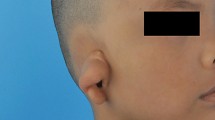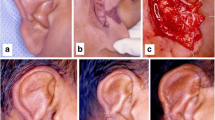Abstract
Background
As a rare auricular deformity, despite numerous surgical procedures for correcting moderate-to-severe question mark ears described in past studies, there remains a need to explore a more cost-effective approach. The optimal utilization of ear cartilage and surrounding skin while achieving superior outcomes continues to pose a significant challenge.
Methods
From 2018 to 2023, twenty-four patients with unilateral question mark ear were enrolled in this study. Seven of them were severe type deformities (absence of lower part of auricle), and seventeen were moderate (only cleft between helix and lobule). All patients were treated with new method using local cartilage and flap without damage in unaffected area.
Results
All patients were satisfied with significant improvement of question mark ear and the overall symmetrical appearance. The surgical scar was not obvious. No complications were observed. The follow-up period revealed that the corrective procedure kept producing the symmetrical and cosmetic results.
Conclusion
Our new method enables optimal utilization of deformed tissue and surrounding skin, rendering this method effective and reliable for correcting moderate-to-severe question mark ears.
Level of Evidence IV
This journal requires that authors assign a level of evidence to each article. For a full description of these Evidence-Based Medicine ratings, please refer to the Table of Contents or the online Instructions to Authors www.springer.com/00266.




Similar content being viewed by others
Reference
Jiang H, Pan B, Guo D, Guo H, Zhuang H (2006) Calsslfication and repairment of “butterfly ear”deformity. Chin J Plast Surg. 22(5):356–358. https://doi.org/10.3760/j.issn:1009-4598.2006.05.011
Cosman B, Bellin H, Crikelair GF (1970) The question mark ear. Plast Reconstr Surg 46(5):454–457. https://doi.org/10.1097/00006534-197011000-00006
Jampol M, Repetto G, Keith DA, Curtin H, Remensynder J, Holmes LB (1998) New syndrome? Prominent, constricted ears with malformed condyle of the mandible. Am J Med Genet 75(5):449–452. https://doi.org/10.1002/(sici)1096-8628(19980217)75:5%3c449::aid-ajmg1%3e3.0.co;2-i
Li Q, Jiang Z, Zhang L, Cai S, Cai Z (2023) Auriculocondylar syndrome: Pathogenesis, clinical manifestations and surgical therapies. J Formos Med Assoc. https://doi.org/10.1016/j.jfma.2023.04.024
Pan B, Jiang H, Zhao Y, Lin L, Guo D, Zhuang H (2010) Clinical analysis, repair and aetiology of question mark ear. J Plast Reconstr Aesthet Surg 63(1):28–35. https://doi.org/10.1016/j.bjps.2008.08.039
Al-Qattan MM (1998) Cosman (question mark) ear: congenital auricular cleft between the fifth and sixth hillocks. Plast Reconstr Surg 102(2):439–441. https://doi.org/10.1097/00006534-199808000-00023
Cosman B (1984) The question mark ear: an unappreciated major anomaly of the auricle. Plast Reconstr Surg 73(4):572–576. https://doi.org/10.1097/00006534-198404000-00009
Park C (1998) Correction of the unilateral question mark ear. Plast Reconstr Surg 101(6):1620–1623. https://doi.org/10.1097/00006534-199805000-00030
Ozturk S, Sengezer M, Isik S, Gul D, Zor F (2005) The correction of auricular and mandibular deformities in auriculo-condylar syndrome. J Craniofac Surg 16(3):489–492. https://doi.org/10.1097/01.scs.0000147655.94656.0d
Posso CM, Wolff GA, Suarez LD (2011) Question mark ear deformity: a combined method for correction. Aesthetic Plast Surg 35(4):646–649. https://doi.org/10.1007/s00266-010-9619-2
Bastidas N, Taylor JA (2013) Correction of the bilateral question mark ear deformity using double-opposing z-plasty and a chondrocutaneous flap. Cleft Palate Craniofac J 50(2):249–251. https://doi.org/10.1597/11-316R
Elsahy NI (2011) The question mark ear deformity and its surgical repair. Plast Reconstr Surg 127(6):140e–141e. https://doi.org/10.1097/PRS.0b013e3182131e4c
Vayvada H, Karaca C, Menderes A, Yilmaz M (2005) Question mark ear deformity and a modified surgical correction method: a case report. Aesthet Plast Surg 29(4):251–254. https://doi.org/10.1007/s00266-004-0136-z
Brodovsky S, Westreich M (1997) Question mark ear: a method for repair. Plast Reconstr Surg 100(5):1254–1257. https://doi.org/10.1097/00006534-199710000-00028
Ali K, Meaike JD, Maricevich RS, Olshinka A (2017) The protruding ear: cosmetic and reconstruction. Semin Plast Surg 31(3):152–160. https://doi.org/10.1055/s-0037-1604241
Funding
Special Program of Clinical and Translational Medicine Research, Chinese Academy of Medical Sciences, 2021-12M-C&T-B-076, Xiaobo Yu, CAMS Innovation Fund for Medical Sciences, 2021-I2M-1-052, Xiaobo Yu
Author information
Authors and Affiliations
Corresponding author
Ethics declarations
Conflict of interest
The authors have no conflicts of interest to disclose.
Human or Animal Participants
All procedures performed in studies involving human participants were in accordance with the ethical standards of the institutional and/or national research committee and with the 1964 Helsinki Declaration and its later amendments or comparable ethical standards.
Informed Consent
For this type of retrospective study, informed consent is not required.
Additional information
Publisher's Note
Springer Nature remains neutral with regard to jurisdictional claims in published maps and institutional affiliations.
Rights and permissions
Springer Nature or its licensor (e.g. a society or other partner) holds exclusive rights to this article under a publishing agreement with the author(s) or other rightsholder(s); author self-archiving of the accepted manuscript version of this article is solely governed by the terms of such publishing agreement and applicable law.
About this article
Cite this article
Wang, T., Yu, X., Jiang, H. et al. New Method Using Local Affected Cartilage and Flap for the Cleft in Question Mark Ear. Aesth Plast Surg (2024). https://doi.org/10.1007/s00266-024-04030-0
Received:
Accepted:
Published:
DOI: https://doi.org/10.1007/s00266-024-04030-0




